Brisbane Olympic Stadium
| Capacity | 60 000 |
|---|---|
| Country | Australia |
| City | Brisbane |
| Clubs | – |
| Category | Design outdated |
| Cost | ? |
| Construction | 2026–2031 |
| Design | Brisbane Design Alliance |
Advertisement
Brisbane Olympic Stadium – design description
What is the Brisbane Olympic Stadium project like in a nutshell?
The Brisbane Olympic Stadium project was the most spectacular concept proposed during the debate over the main venue for the 2032 Olympic Games, to be held in Brisbane, Australia.
The plans were drawn up by a private consortium of renowned architectural firms from Australia and abroad. The project was presented in August 2024 as an alternative to the overly modest plans pushed by the authorities at the time.
The project called for the construction of a 60,000-seat stadium, distinguished by its original and expressive form. The stadium was to stand on an artificial island, and the attention was drawn to the three wide promenades flowing seamlessly into the roof over the auditorium in addition to a tall building towering over the north stand.
In March 2025, the new state government unveiled a comprehensive sports infrastructure plan for the Games, including a new concept for the main stadium to be built in Victoria Park. Thus, the impressive vision of the Brisbane Olympic Stadium, which from the start was skeptically welcomed by politicians, has been definitively abandoned.
How did the concept for a new Brisbane Olympic Stadium come about?
On August 17, 2024, a new urban design for Brisbane, called Northshore Vision 2050, was presented. Part of the project was to be a multi-purpose stadium with stands for 60,000 spectators, which could become the main venue for the 2032 Olympic Games.
Work on the concept took six months. The project was an initiative of the Brisbane Design Alliance, a consortium of local and foreign architectural studios with globally recognized expertise: Buchan, HKS, NRA Collaborative, Aurecon and Nikken Sekkei.
How much was the Northshore Vision 2050 project expected to cost to implement?
Implementation of the entire project was to cost A$6 billion. The investment was to be financed with private funds, although the initiators hoped that local authorities would donate land for construction free of charge, as well as make improvements to the transportation infrastructure in the area.
The plan was to be implemented over a period of years, and the first stage was to be primarily the preparation of the facilities needed for the Games, including the stadium and the Olympic village, which was later to be transformed into a residential area.
Where was the new Brisbane Olympic Stadium planned?
The development was planned in Northshore Hamilton, on the Brisbane River waterfront, a few kilometers east of Brisbane's inner city. The plan called for the construction of footbridges leading to the Doomben railroad station and across the river to the Bulimba district.
Interestingly, a new stadium was proposed for the same site as early as 1998, but the idea was abandoned after the authorities changed, and Lang Park was redeveloped instead. In contrast, the authorities' original plan for the 2032 Games called for the construction of an Olympic village at the site.
What did the vision for the new Brisbane Olympic Stadium include?
The centerpiece of Northshore Vision 2050 was to be a stadium with a capacity of 60,000 spectators. The facility was to take a very original, extravagant form. Attention was drawn to the three wide promenades leading into the stadium, which flowed seamlessly into the canopy over the stands. Above the stands on the northern side was to be a residential building.
The stands were to be given an oval shape, suitable for hosting cricket and Australian football matches. It was also to be possible to place an athletics track inside, so that the stadium would serve as the main venue during the Olympic Games. A large number of boxes were also planned above the auditorium, and the stadium was to be equipped with modern technology.
A gap was planned on the southwest curve, through which a large part of the audience could observe the skyline of Brisbane's downtown (central business district) with its tall skyscrapers.
What was planned for the surroundings of the new Brisbane Olympic Stadium?
The project included a new shoreline arrangement to resemble the former meanders of the Brisbane River. A new channel was designed around the stadium, so that the facility would actually be on an artificially created island, connected to the mainland by several footbridges.
In addition to the stadium itself, the Northshore Vision 2050 project also included the creation of an Olympic village, a swimming center, a hotel, restaurants, new retail and commercial space as well as apartments. The revitalization of the area included the creation of new pathways, green spaces and water marinas to turn it into an attractive public space.
What role was the new Brisbane Olympic Stadium expected to play during the 2032 Olympics?
After Brisbane was awarded the hosting of the 2032 Olympic Games in 2021, the issue of the stadium that would be the main venue for the event arose. Initially, it was to be a redeveloped The Gabba, and later a new venue in Victoria Park was also considered.
In March 2024, these ideas were rejected, and a new plan called for the redevelopment of the Queensland Sport and Athletics Center. The initial assumptions, however, were remarkably modest: the stadium was to hold 40,000 spectators, most of which would be temporary stands without canopies.
Meanwhile, the new concept for the Northshore was prepared with flair and a great deal of originality, providing an interesting alternative to the plans prepared by the authorities, especially since the facility was to be built with a large share of private capital. The vision was even described by some media as “saving the Games for Brisbane”, although the first reactions of those in power to the new proposal were rather skeptical.
When was the Brisbane Olympic Stadium to be built?
Originators hoped to open the stadium in 2031, a year before the Games. In order to be able to fit in the schedule and make it in time for the Games, work was to start no later than in 2026.
How was the Brisbane Olympic Stadium to be used after the Games?
Numerous commercial functions were to guarantee the maintenance of the facility after the 2032 Olympics. Thanks to its oval form, it would be possible to organize matches of the popular cricket and Australian football, and the facility could attract one of the local professional teams. The facility would be suitable for major sporting events, as well as concerts and other activities.
Will the Brisbane Olympic Stadium project come to fruition?
Following the state election in October 2024, newly elected Queensland Premier David Crisafulli ordered a 100-day review to settle the question of a stadium for the Games. The audit resulted in the 2032 Delivery Plan, which was announced on March 25, 2025. The document identified not only the main stadium, but also the other venues to host the Olympic Games.
According to the new plan, the main stadium for the 2032 Olympic Games is to be built in Victoria Park, where an Olympic stadium had already been proposed in the past. The plan also presents a preliminary rendering of the facility and the first details of the project. With this, all previous projects were rejected, including a proposal for a stadium in Northshore Hamilton.
Advertisement
Renderings
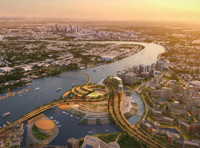
2024 © Brisbane Design Alliance 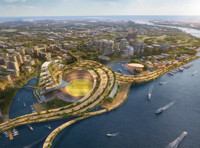
2024 © Brisbane Design Alliance 
2024 © Brisbane Design Alliance 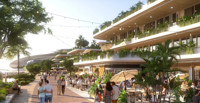
2024 © Brisbane Design Alliance 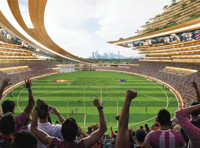
2024 © Brisbane Design Alliance 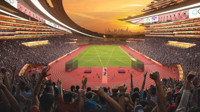
2024 © Brisbane Design Alliance 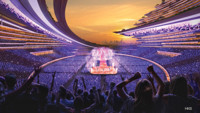
2024 © Brisbane Design Alliance
Related news
2024
-
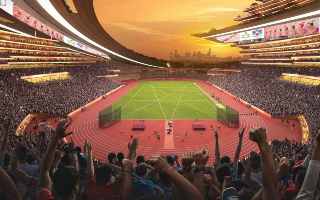
Australia: Brisbane selects Olympic stadiums for 2032 Games
The 2032 Olympic Games present a huge opportunity and challenge for Brisbane. The Queensland capital has begun a 100-day site review for an Olympic stadium. Options are plentiful, with choices including the legendary The Gabba or the futuristic Northshore Hamilton.
-
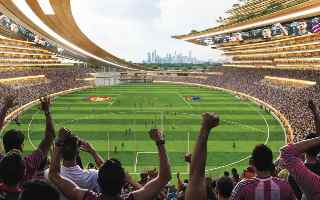
Australia: Will Northshore Hamilton Olympic Park be built?
With Queensland's newly inaugurated LNP government conducting a 100-day review of Brisbane's Olympic stadium options, attention has shifted to viable urban sites for the games.
-
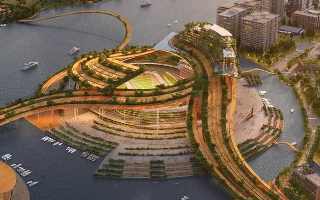
Australia: Privately funded Olympic complex for 2032 Games?
Brisbane, as host of the 2032 Olympic Games, faces a huge challenge. The city, grappling with time pressures and the need to meet high expectations, is on the threshold of transformation. Preparations for the construction of the Olympic complex have begun.

 StadiumDB
StadiumDB